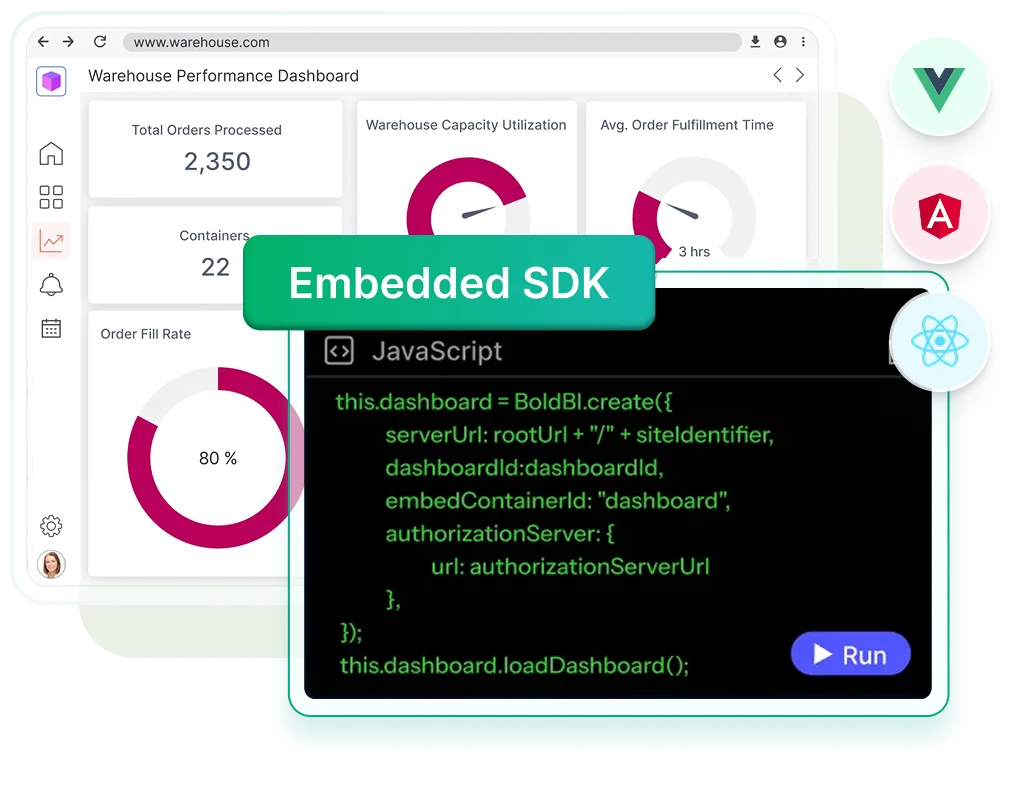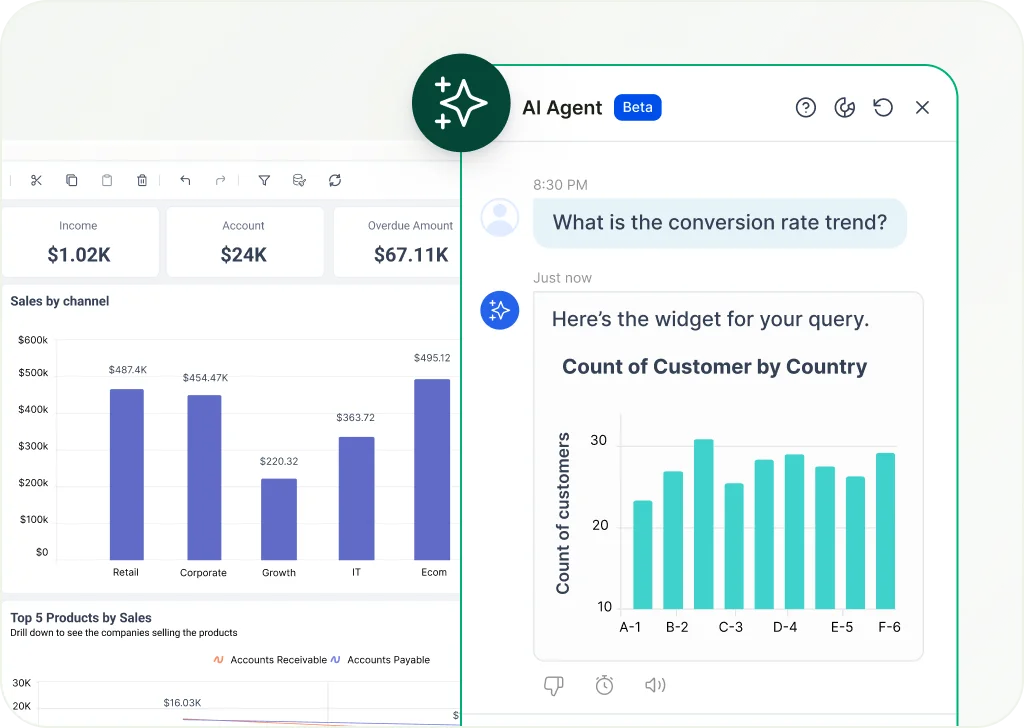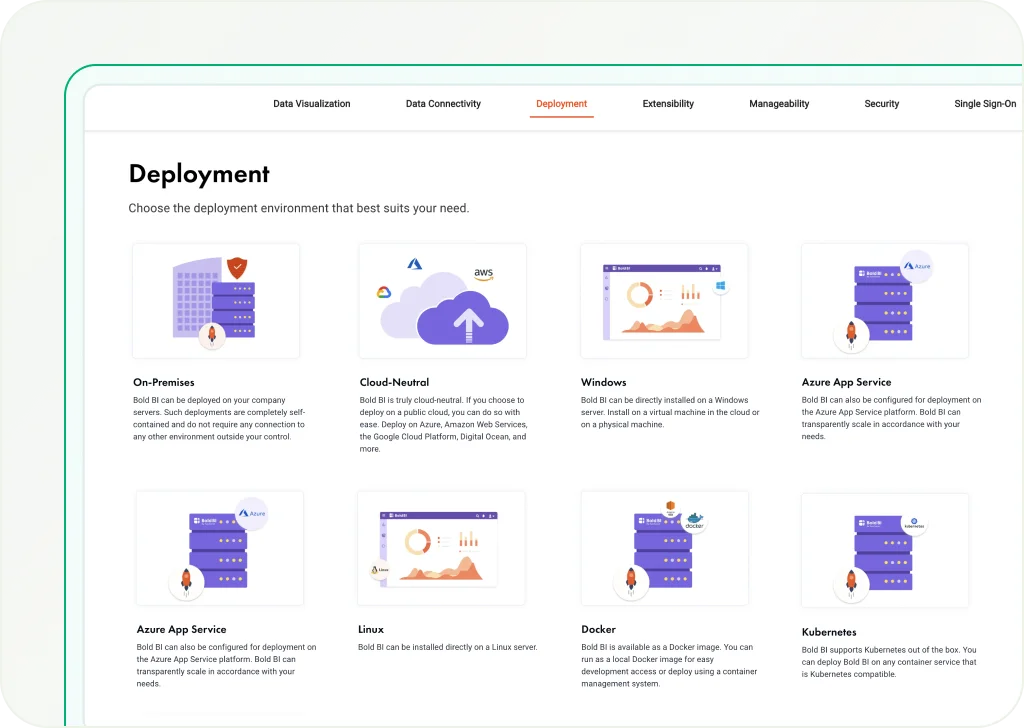Embedded Analytics Built for Your App
Your application needs analytics that are smooth, strong, and truly embedded. With Bold BI, you can add dashboards, AI-driven insights, and custom branding in just a few days—with simple pricing.
No credit card required.

Trusted by world-class companies









Key Features of Embedded Analytics Platform
Don’t let analytics slow you down. Bold BI fits into your app, gives fast insights, and grows with your business—so you can focus on building great products.
Easy Integration and Custom Experience
Users want dashboards that feel built-in. Bold BI makes it easy to embed, brand, and run smoothly on any device.
Add dashboards to React, Angular, Blazor, Vue, .NET, and more using simple and flexible APIs.
Use JavaScript SDK and REST APIs to embed dashboards with full control and easy automation.
Let users build and edit dashboards inside your app for a smooth and interactive experience.
Embed the full Bold BI platform into your product or service for complete control and flexibility.
Use themes, CSS, and JavaScript to style dashboards to match your app’s look and feel.
Dashboards adjust to any screen size with mobile-friendly layouts and smooth performance.
Match your brand with custom fonts, colors, logos, and layouts for a consistent user experience.

AI-Powered Insights and Fast Decisions
Bold BI helps users explore data, find trends, and make smart choices with AI and live dashboards.
Use smart chat and auto visuals to explore data, uncover trends, and gain insights quickly.
Share live dashboards as dynamic presentations to improve clarity and audience engagement.
Keep dashboards updated with live connections for fast, accurate, and real-time decisions.
Add comments and notes to dashboards for better teamwork, faster feedback, and shared understanding.
Download dashboards as PDF, Excel, Word, or images for easy sharing across teams and platforms.

Scalable Deployment and Secure Access
Bold BI gives IT teams and developers the tools to deploy anywhere, protect data, and manage users easily.
Run Bold BI in cloud, on-premises, or hybrid setups with support for Docker, Kubernetes, Linux, Azure App Service and Windows.
Protect sensitive data with SSO, RBAC, and encryption while meeting global security standards.
Host multiple tenants securely with isolated or shared models, strong access control, and easy management.
Save custom dashboard views for different users. Share them easily so everyone sees what’s relevant to them.
Connect to over 120 sources including databases, files, and APIs for smooth and flexible data access.
Support multiple languages, formats, and time zones for a truly global and user-friendly experience.

Why Choose Bold BI for Embedded Analytics
Bold BI helps you add smart analytics quickly and securely. It improves user experience, saves development time, cuts costs, and helps users make better decisions.
AI-Powered Insights
Ask in plain language and get instant, AI-powered dashboards to make faster, smarter decisions.
Embed Anywhere
Embed dashboards in apps built with React, Angular, Blazor, Vue, .NET, and more using flexible APIs.
White-Labeled
Easily style and personalize dashboards to match your app using custom fonts, colors, logos, and flexible layouts.
Enterprise-Grade Security
Protect data with SSO, RBAC, and encryption while meeting GDPR, HIPAA, SOC 2, and other standards.
Flexible Deployment
Deploy in cloud, on-premises, or hybrid setups with support for Docker, Kubernetes, Linux, Azure App Service & Windows.
Multitenancy Support
Host multiple tenants with shared or isolated models, secure access, and easy resource management.
Simple Pricing
Bold BI offers tailored plans with no per-user fees—just the features and support your business needs.
Dedicated Support
Get expert help 24/5 for setup, quick troubleshooting, and friendly custom guidance from our support team.
Support and Resources
Get the help you need to make the most of Bold BI’s embedded analytics—quickly and confidently.
Comprehensive Documentation
Follow easy guides and tutorials to set up, embed, and customize dashboards.
Dedicated Support Team
Reach out to our experts for fast help with setup, issues, or questions.
Tutorials and Webinars
Learn from live sessions and videos to improve your skills and explore new features.
What Our Customers Say About Us
See what our customers say about us and our embedded analytics and business intelligence product.
What we liked best was the ability to connect to on-prem data sources, easy connectors, embedding visualizations, and a reasonable cost.

We evaluated a bunch of dashboard solutions for one of our top clients. Finally, we zeroed down on Syncfusion. We are super happy with the results.

I like a lot of the dashboard features. The new user management server helps me to handle the users and authentication all in one place.

Now I can basically provide anything the customer needs from their dashboard, and I really don't have limitations. I can customize anything.

Frequently Asked Questions
You can embed dashboards using our JavaScript SDK or REST APIs. Bold BI provides ready-to-use code samples and detailed documentation to help you integrate analytics seamlessly into web apps built with frameworks like React, Angular, Vue, Blazor, or ASP.NET.
Yes. Bold BI supports full white-labeling. You can apply your own colors, fonts, and logos or even use custom CSS and JavaScript to make the embedded analytics look like a native part of your product.
Bold BI supports secure authentication methods including Single Sign-On (SSO), OAuth 2.0, OpenID Connect, and JSON Web Tokens (JWT). These ensure that users can access dashboards safely without separate logins.
You can connect to over 120 data sources—ranging from SQL and NoSQL databases to cloud apps like Google Analytics, Salesforce, and REST APIs—allowing you to visualize live, real-time data directly inside your app.
Most developers can embed their first dashboard in just a few hours. Bold BI’s quick-start guides, SDKs, and sample projects make integration fast and straightforward.
Get Started with Our Embedded Analytics
Deliver powerful dashboards inside your app—without the complexity, high costs, or branding limits. Bold BI makes it fast, secure, and scalable to give your users the insights they need.
No credit card required.


